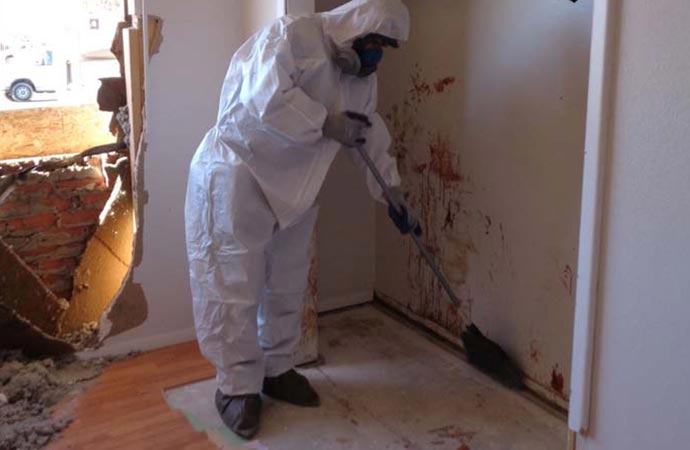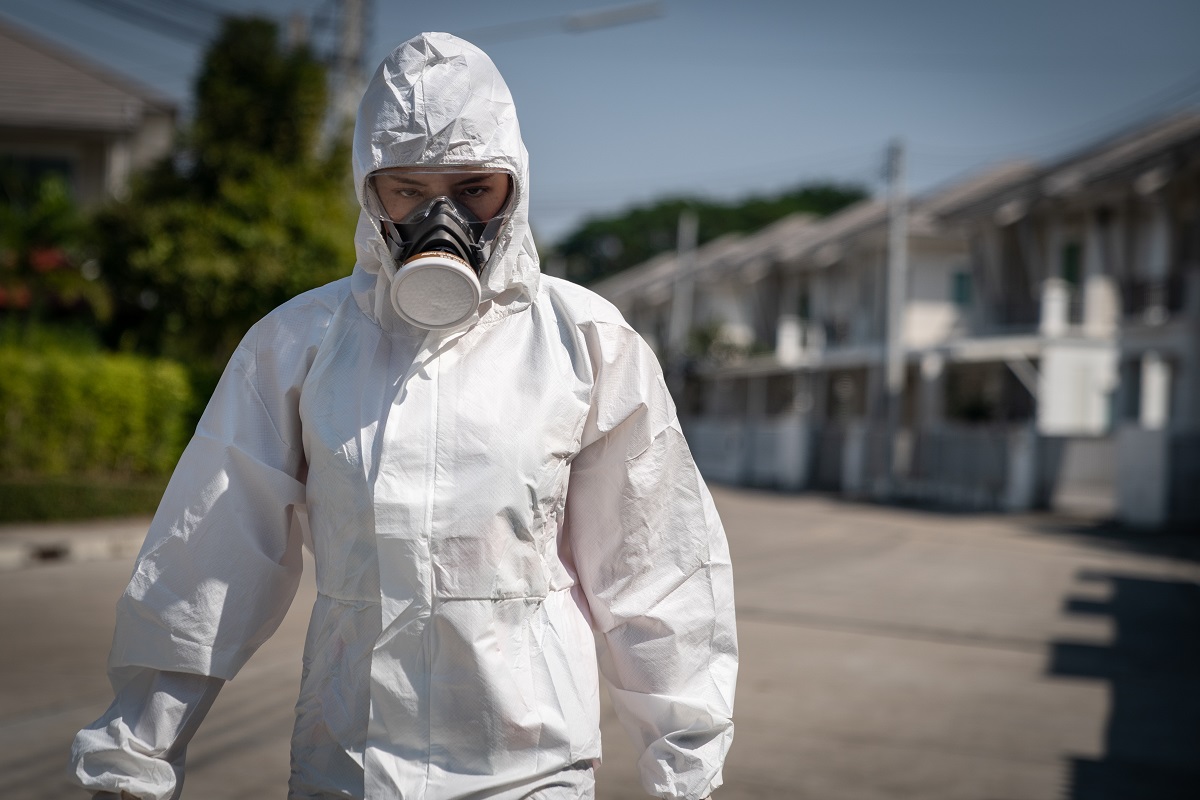Decomposition Death Clean Up: Specialized and Respectful Remediation
Decomposition Death Clean Up: Specialized and Respectful Remediation
Blog Article
Professional Biohazard Cleansing and Purification for Blood, Bodily Fluids, and Hazardous Materials
The possible health dangers linked with direct exposure to biohazards emphasize the vital demand for thorough handling and thorough clean-up. As we browse the intricate landscape of biohazard clean-up, recognizing the subtleties of laws, conformity, and the customized equipment at play becomes important in making sure a safe and complete purification process.
Health Dangers of Biohazard Exposure
Exposure to biohazards postures significant health and wellness dangers that can cause serious repercussions for people and communities alike. Biohazards encompass a large range of organic compounds, including blood, physical fluids, mold and mildew, bacteria, infections, and other possibly contagious products. When individuals enter call with these biohazards, whether via accidents, improper handling, or environmental direct exposure, they deal with the risk of having serious health problems or diseases.
One of the primary health threats connected with biohazard exposure is the transmission of infectious illness. Bloodborne virus such as HIV, hepatitis B and C, and numerous microorganisms can be present in biohazardous materials, posing a straight threat to human health. Inhaling air-borne biohazards like mold spores or entering into contact with contaminated surface areas can also bring about breathing issues, allergies, and other unfavorable wellness effects.
Furthermore, biohazard direct exposure can have long-term health and wellness ramifications, with some diseases showing up years after the initial get in touch with (Blood Cleanup). For that reason, it is crucial to focus on proper biohazard cleansing and purification to reduce these wellness risks and make sure the safety and security of people and communities

Specialized Educating for Biohazard Cleaning
When it involves managing biohazard cleanup efficiently and securely, specialized training plays a fundamental function in making certain appropriate purification procedures are adhered to. Biohazard cleaning calls for particular expertise and skills to efficiently minimize dangers linked with bloodborne virus, physical fluids, and harmful products. Professionals educated in biohazard clean-up go through rigorous instruction on just how to safely manage, get rid of, and take care of biohazardous products to avoid contamination and direct exposure.
Specialized training for biohazard clean-up covers a variety of crucial topics, consisting of appropriate personal safety equipment (PPE) use, bloodborne microorganism recognition, decontamination methods, and contaminated materials disposal protocols. People learnt biohazard clean-up are equipped with the essential know-how to examine contamination levels, recognize possible dangers, and execute proper clean-up procedures in conformity with regulatory requirements.
Continuous training and education are paramount in the area of biohazard cleanup to remain updated on the most recent purification technologies, safety and security methods, and policies. By buying specialized training, biohazard cleaning specialists can effectively react to emergency situation clean-up circumstances and protect both public wellness and the environment.
Relevance of Appropriate Decontamination Methods
Using correct purification techniques is important in biohazard clean-up to properly remove unsafe products and minimize health and wellness dangers. Effective decontamination not only makes certain the removal of noticeable traces of blood, bodily fluids, and other biohazards however additionally targets unseen microorganisms that may pose major health dangers otherwise appropriately removed. By adhering to rigid decontamination procedures, educated experts can dramatically decrease the danger of direct exposure to harmful bacteria, viruses, and bacteria that can lead to check my site diseases or infections.
Appropriate decontamination methods include making use of specialized devices and anti-bacterials that are especially made to counteract biohazards properly. Detailed cleaning and sanitation her comment is here of infected locations are necessary to avoid the spread of pathogens and make certain a risk-free environment for occupants. Additionally, the correct disposal of biohazardous waste following purification treatments is vital in preventing contamination of various other surface areas or people.

Tools and Devices for Safe Cleanup
When dealing with blood, physical liquids, or hazardous products, biohazard cleaning professionals rely on specialized equipment to reduce direct exposure dangers and extensively decontaminate the damaged location. In addition, biohazard cleansing kits having anti-bacterials, absorbing products, and biohazard bags are used to safely dispose and include of polluted items.
Advanced cleaning devices like hospital-grade anti-bacterials, HEPA-filtered vacuum cleaners, and fogging makers are used to sterilize surface areas and get rid of biohazards efficiently. Specialized equipment such as sharps containers and biohazard waste disposal bins are used to safely manage sharp things and biohazardous waste materials. By using the right equipment and devices, biohazard cleaning experts can ensure a thorough cleaning process that prioritizes security and reduces health threats for both workers and residents of the affected area.
Rules and Compliance in Biohazard Cleaning
Appropriate adherence to policies and conformity requirements is extremely important in biohazard cleansing to guarantee the safety of both workers and the setting. Government firms such as OSHA (Occupational Safety and Health Management) and the EPA (Epa) have established details standards for biohazard cleanup procedures to reduce wellness risks and environmental contamination. These regulations cover a variety of facets including the handling, transport, and disposal of biohazardous materials, as well as the necessary training and protective devices needed for employees associated with the clean-up procedure.
Biohazard cleansing firms should stay up-to-date with these policies to guarantee that their operations fulfill the required safety criteria. Failure to follow these regulations can cause serious consequences, including penalties, legal action, and threatening the health and wellness of individuals and the atmosphere. By complying with stringent laws and conformity procedures, biohazard cleansing business can properly mitigate threats and make certain a safe and comprehensive cleanup process for all events involved.
Conclusion
To conclude, biohazard cleansing and purification need specialized training, correct methods, and important site adherence to guidelines. Direct exposure to blood, bodily fluids, and dangerous products poses significant health and wellness risks, making it vital to utilize the right devices and devices for risk-free clean-up. By adhering to rigorous protocols and standards, professionals can properly mitigate the dangers connected with biohazard direct exposure and guarantee the security of both themselves and others.
As we navigate the intricate landscape of biohazard cleaning, recognizing the nuances of policies, compliance, and the specific equipment at play comes to be important in making sure a risk-free and thorough purification procedure. (Blood Cleanup)
When it comes to taking care of biohazard cleaning efficiently and safely, specialized training plays a fundamental duty in making sure appropriate decontamination procedures are followed.Utilizing correct decontamination strategies is essential in biohazard clean-up to effectively reduce and remove harmful products health dangers. Additionally, biohazard cleaning sets containing anti-bacterials, absorbing products, and biohazard bags are used to safely get rid of and consist of of infected things.
Federal government agencies such as OSHA (Occupational Security and Health Administration) and the EPA (Environmental Security Company) have actually established details guidelines for biohazard clean-up treatments to minimize health risks and environmental contamination.
Report this page